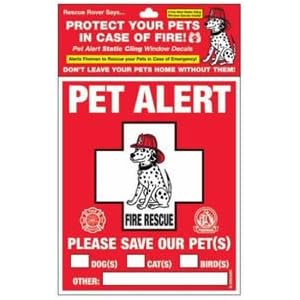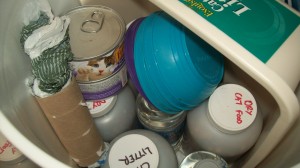The Red Cross and the SPCA recommend that in addition to an Emergency Kit for you and your family, you create one for your pets. This is important step can help to save your pets live and your peace of mind. Many animal related groups have chimed in to build on the Red Cross list of emergency items for your pet.
During any sort of evacuation or emergency, having an emergency plan and kit for pets can give you peace of mind. A Pet Emergency Kit is simple to prepare and takes very little time.
Decal
First, you should have a reflective emergency sticker on a window facing the front of the house. This is similar to the stickers used for children.

They are generally very inexpensive or can be obtained free from animal welfare groups or even your local fire department. If you do evacuate your home, put a sign over the decal saying that you evacuated the animals as well.
Plan
Next you need a plan. Do you have someone you could board your animals during an emergency. Make a list and contact them. Is there a neighbor you could give your key to who would be able to take your pet out of your house if disaster strikes and you are at work? Make sure they know where your Emergency Kit is.
Make a list of the hotels within an hour or two drive that take pets. Print the list and keep it in your Emergency Kit.
Building Your Kit
No matter what type of pet you have from dogs to gerbils, your pet is going to need food, water, and a place to poop.
Food. First gather about a weeks worth of food. Some small pets might need a salt lick as well. This needs to be stored in containers that are water proof and well labeled. Plan to rotate this at least every six months. Don’t forget dishes, spoons and dish soap. If you are living in hotel with your pet, you will want to have a way of cleaning their dishes daily. Be sure to include spoons and a can opener if you have canned food.
Water. Store bottled water just for your pet for a week. Then add an extra bottle or two just in case. Be sure to pack a dish or collapsible bowl.
Poop. Even in an emergency, your pet will need a place to relieve themselves. For cats, be sure to pack a disposable or small litter box, litter, and a scoop. For small animals, pack bedding to last a week. And for all animals, pack disposable bags for poop and litter. Keeping clean and keeping water sources clean is especially important during disasters, so putting your pet’s poop in a plastic bag can help.
Restraints. If you have a cat or dog, have an extra harness and leash in your kit. For small pets, plan on taking them in their cage or have a small cage available for transport.
For cats, birds, and other small pets, tuck an old pillow case in your Kit. This will allow you or an emergency aid worker to handle or transport your pet safely. Even if you don’t live in a flood-prone area, just think about how you would transport your cat from a roof top to a boat bobbing on the water.
For birds, add a catch net in your kit. Even if you plan on transporting your bird in a cage, there are always accidents where a catch net would come in handy.
Documentation. Photo copy your pet’s most recent vaccination list and health report. Many shelters cannot take animals without certain vaccines. Also keep a photo of you and your pet as well as one of your pet alone. If you can, have your pet fitted with a microchip. These can aid in reunification if you are separated.
Comfort. Pack some of your pets favorite treats or comfort objects. An old fleece or a soft towel will do nicely for an emergency bed. All the better if it smells like you. For birds and small animals, in times of stress, many like to chew more than usual, so include a few safely chewable objects.
Other supplies. In any emergency kit, you should keep a flashlight and a small first aid kit.
Storage

You will need to be able to carry your emergency kit, so when you are packing it up keep that in mind. You will also need to rotate the food at least every six months.
Ideally your storage will be water proof and animal proof, so a five-gallon bucket works well as does a back pack stored in a tote. Whatever you choose, store it in an easily accessible location – just in case.










































Leave a Reply